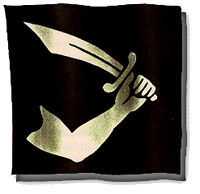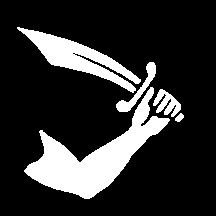The pirate flag of Captain Tew and his crew
Tew's flag had neither skulls nor bones, but simply an arm wielding a sword signifying power.

Sir Thomas Tew seemed to think it more polite to suggest violence in his flag rather than death, and took the image of the sword rather than skull or bones.
The message however was no less clear regarding the fate of any who opposed his advance. The images on a pirate flag were designed to indicate a certain message. They were interpretive, but well known in the golden age of piracy. The skull was a sign of death, but a skeleton, often with horns, indicated a tormented death. A dart or spear was used to indicate a violent death in contrast to the bleeding heart denoting a slow and painful death. The hourglass gave a threat that time was running out or that capture was inevitable.
A raised fist or hand clutching a dagger or cutlass was to indicate a general willingness to kill. This was the image Tew chose.
Curiously, the pirate Blackbeard managed to incorporate practically every one of these main symbols into his flag, whereas Jack Rackham (Calico Jack) used a graceful set of crossed swords in place of bones to boast ironically of his willingness to fight.
While pyrates often flew "false colours" of any given country, they inevitably used "truer" colours to communicate and threaten potential victims. In general, a white flag was flown when pirates were in chase of a potential victim. In some cases the victim would "strike his colours", or take down the king's flag and submit to the bandits. If the victims refused, a black and white flag was raised to indicate the intentions of the pyrates. In the event that a ship was particularly evasive, or a pyrate was particularly brutal, a red flag was raised to indicate that no quarter would be given (no lives would be spared) once the ship was captured. The first such flag was flown by Emmanuel Wynne around 1700 as he plundered the Caribbean.
The Jolly Roger, Old Roger, or just plain Skull and Crossbones is the definitive symbol of the pyrate. It is believed that the name derives from joli rouge, which means "Pretty Red" in French. This was taken to describe the blood red flags flown by particularly harsh pyrates. The primary use of such a banner was to strike fear into the hearts of the crew under pyrate attack.
